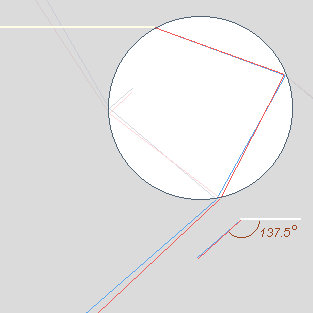
OpticsPOD
What's New
Rays & Shadows
Water Droplets
Rainbows
Not a rainbow!
Primary Bow
Raindrop Rays
Rainbow Cone
Low & High Bows
Drop size
Colours
Secondary Bow
A's Dark Band
Other Orders
Supernumeraries
Red Bows
Rainbow Wheel
Dew Bow
Sea Spray Bow
Glass Bead Bows Reflection Bows
Twinned Bows
Cloud Bows
Moon Bows
Image Gallery
Simulators
Ice Halos
High Atmosphere
Links & Resources
Search - Index
123456789012345678
| Through a drop brightly - light rays |
 |

|
|
|
Rays** reflected once inside raindrops make the primary. Its colours are produced by the two refractions as the rays enter and leave. Rays are deviated back towards the incoming sunlight to form a bow appearing opposite the sun. The rays drawn in lighter tones form the "zero order glow", the secondary and higher order bows. |
One internal reflection produces the primary bow. |
||
| Mouse
over the slider to see the ray paths. Rays close to the drop centre
are deviated almost 180º back on themselves.
Rays further from the centre are deviated less and less until the
deviation reaches a minimum (about 137.5º for deep red light).
This is the "angle of minimum deviation" or "rainbow
angle". The deviation increases once more as the entrance
ray approaches the drop rim . |
Light is deviated into a whole range of angles | |||
| Rays
cluster strongly around the rainbow angle, test it with the
mouse, and so the bow is at its brightest at that angle. Rays near
the rainbow angle form the bow's bright outer edge. |
Minimum deviation angle | |||
| Red
light is refracted less than blue and its minimum deviation angle
is less. Red is therefore on the outside of the primary bow. |
Colour separation | |||
| Rays
deviated through larger angles make the sky brighter inside
the primary. The brighter sky is colourless because at those angles
the colours strongly overlap. |
Bright sky inside the bow | |||
| No
light is deviated through angles smaller than the minimum deviation
angle and the sky is therefore darker beyond the outer edge of the
primary bow. |
Outside the bow is dark | |||
| *
|
Raindrops
are never the tear shaped objects beloved of illustrators. Small
raindrops are kept strongly spherical by surface tension forces. Larger
drops are sometimes flattened by air resistance as they fall and they
may even oscillate or wobble. Even small departures from sphericity
destroy a rainbow or possibly cause some odd
effects. |
Spheres not teardrops | ||
| **
|
Ray
paths are something of a fiction and geometric optics is incapable
of explaining many aspects of rainbows. However, when raindrops are
a millimetre or so in diameter the straight line rays are a reasonable
approximation to some aspects of how light behaves. |
Don't take ray paths too seriously | ||
| *** | Deviations
are traditionally measured from the direction of the incoming sunlight.
The deviation angle for red rays forming the edge of the primary bow
is about 137.5º. The centre of a rainbow is directly opposite
the sun (a deflection angle of 180º). The radius of the red edge
of the primary is therefore 180-137.5 = 42.5º |
Deviation angles | ||
| **** | The
ray paths are accurately computed for wavelengths of 400 and 750 nm
passing through a water drop at 0 Celsius. |
Calculation | ||